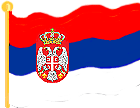Fatiše Kolo
Fatiše Kolo is a traditional dance from the south Serbian town of Vranje. It's pronounced "Fah-tee-sheh Koh-loh".
Fatiše Kolo
Fatise Kolo
Folk Dance Song
Folk Dance Song
(Serbian)
(English)
Fatiše Kolo vranjske devojke.
Vranjske devojke na tu vranjsku česmu.
Na čelu kola, Mitkina taša
Mitkina taša, lepotica naša
The girls from Vranje started a circle dance
The girls of Vranje, at Vranje's fountain.
At the head of the round is damsel Tasa
Damsel Tasa, our beauty*.
Notes
*The beauty of Vranje
Here's what Aleksandra Grbic Hrustic wrote about the name of this song:
"'Fatiše' comes from the old Serbian language, not in use any more, actually the proper word would be "uhvatiše". That means: 'they joined hands'. So, together 'Fatiše kolo' literally means 'they joined hands for the circle dance' or 'they (Vranje's girls) started a circle dance'.
It is also known as 'Kolo from Vranje' ('Vranjsko devojacko kolo'), but it's also common to name Serbian folk songs by the first line."
*****
Another version with an alternate 2nd verse:
Fatiše Kolo vranjske devojke.
Vranjske devojke na tu vranjsku česmu.
Na chelu kola Živkova Taša
Živkova Taša, lepotinja naša.
English Translation:
The girls from Vranje started a circle dance
The girls of Vranje, at Vranje's fountain.
At the head of the round is Mitko's* Tasha.
Mitko's* Tasha, our beauty."
*Or Chicko's, or Zhivko's daughter. Mitko, Chicko, or Zivko are common names (or nicknames) for men in Southern Serbia, so if someone says "Mitko's Tasha", it usually means a daughter of Mitko (could be a girlfriend, or a wife, but not so often). So damsel is a fair description.
Comments
Ed sent dance instructions:
Dance instructions
Formation: Line dance, women only: hands held lightly at shoulder height with elbows bent;
Line moves R; begin facing slightly R.
Sequence:
Weight is on L foot. Lift L (quick), step R (slow), lift R (quick), step L (quick);
Lift L (quick), step R (slow), facing center step L in front of R (quick), step on R in place (quick)
Lift R (quick), step on L in place (slow), step on R in place of L (quick), step on L in place (quick).
The dance does not equal the musical phrase, but begins again mid-verse. This should not trouble the dancers, who simply continue repeating the step sequence.
Note: the steps in this dance are hesitating, and delicate; body movements are supple, almost serpentine. The dance is from the Prizren-Vranje area which was heavily influenced by the Turks.

Thanks!
Thanks!
Thanks and Acknowledgements
Many thanks to Ed Gawlinski for contributing this song. Translated by Mama Lisa and Aleksandra Grbic Hrustic. Aleksandra is a music teacher from Novi Sad, Serbia. She teaches music to children from 1.5 to 7 years old in her music school "Melodium".
Hvala lepa!

























